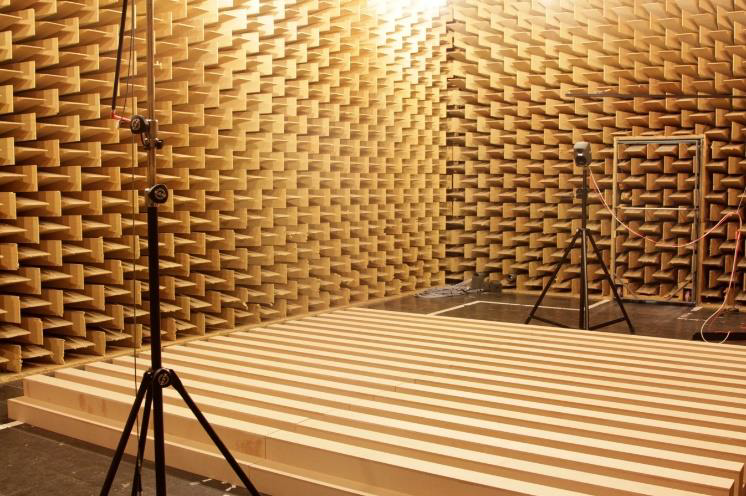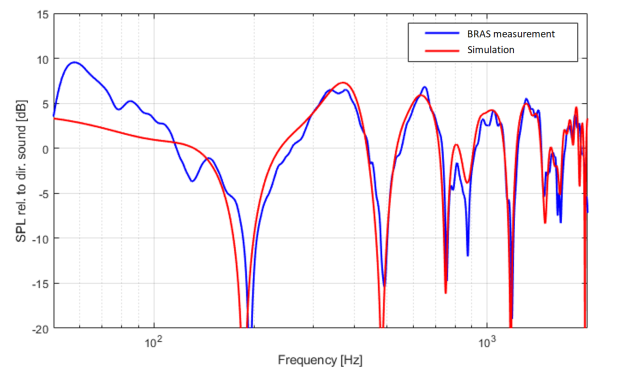Wave-Based Approach
For the low frequencies, Treble's sound simulation engine consists in directly solving the wave equation in the time domain numerically. This has the advantage of not introducing any further physical approximation to sound propagation, and inherently accounts for all wave phenomena relevant to room acoustics, such as wave interference, scattering, diffraction, modal behavior, etc. Our newly developed solver is based on the discontinuous Galerkin (DG) method [1] and fulfills your needs if you do not want to compromise on accuracy. The solver is optimized to run on massively parallel high-performance computing (HPC) clusters using graphics processing units (GPUs).
Acoustic wave propagation in a three-dimensional space can be described by the following system of linear first-order partial differential equations:
where is the acoustic pressure [Pa] at time and at a given location, is the 3D particle velocity vector [m/s], is the air density (assumed equal to kg/m³), is the sound speed in air (assumed equal to m/s), and is the nabla differential operator. This set of equations is exactly equivalent to the more commonly used second-order wave equation. The DG method is capable of very accurately solving the above equations inside a given spatial domain (room), together with suitable boundary conditions. The approach relies on a high-order discretization in time and space of the propagation equations in order to iteratively yield a solution in terms of and across the whole domain. For the sake of brevity, the numerical details are omitted here and the reader is referred to Refs. [2-7] for an in-depth description.
Example of Results
An accurate room acoustics prediction must include wave phenomena thoroughly, such as diffraction. Diffraction is a spread of energy from the dominant direction of wave propagation, which can cause sounds to "bend" around corners and be heard at out-of-sight locations. A common example is that one can hear a person even though the person is not visible, e.g, through a door opening. Diffraction is important in rooms with furniture and with complicated geometries, mainly at low frequencies.
Most room acoustics software tools, particularly using energy-based geometrical acoustics solvers, cannot account for diffraction accurately. This is thoroughly documented in the scientific literature [8-9]. Treble's wave-based engine is the only room acoustic software that can successfully capture the reflection and diffraction behavior of a geometrically complex surface [10]. This is illustrated below, where our wave-based solvers is able to very accurately reproduce the results from the "Benchmark for Room Acoustical Simulation" database [11].

(Figure taken from [4])

Computation Time
The computational cost of a DG simulation (or virtually any time-domain wave-based simulation) is fundamentally determined by the highest resolved frequency (referred to as the transition frequency in the following), the volume of the considered domain , and the length of the simulation . As a rule of thumb, the computation time is linearly proportional to both and , but is proportional to the highest frequency elevated to the power of four, i.e., . In practice, this means that simulating for an extra octave band adds a factor of 16 to the computation time.
Despite our highly optimized wave solver, the computation cost can necessarily become expensive for the higher frequency bands; our sound engine is therefore supplemented with a geometrical acoustics solver in order to simulate these high frequencies more efficiently.
References
[1] W. H. Reed, T. R. Hill. Triangular mesh methods for the neutron transport equation (No. LA-UR-73-479; CONF-730414-2), Los Alamos Scientific Lab, 1973.
[2] M. Käser, M. Dumbser. An arbitrary high-order discontinuous Galerkin method for elastic waves on unstructured meshes - I. The two-dimensional isotropic case with external source terms, Geophys. J. Int., 166:855-877, 2006.
[3] M Dumbser, M Käser. An arbitrary high‐order discontinuous Galerkin method for elastic waves on unstructured meshes – II. The three‐dimensional isotropic case. Geophysical J. Int., 167:319-336, 2006.
[4] J. S. Hesthaven and T. Warburton. Nodal discontinuous Galerkin methods — Algorithms, analysis, and applications. Springer, New York, 2008.
[5] F. Pind. Wave-based virtual acoustics, PhD thesis, Technical University of Denmark, 2020.
[6] H. Wang, I. Sihar, R. Pagan Munoz, and M. Hornikx. Room acoustics modelling in the time-domain with the nodal discontinuous Galerkin method. J. Acoust. Soc. Am., 145(4):2650–2663, 2019.
[7] F. Pind, C.-H. Jeong, A. P. Engsig-Karup, J. S. Hesthaven, and J. Strømann-Andersen. Time-domain room acoustic simulations with extended-reacting porous absorbers using the discontinuous Galerkin method. J. Acoust. Soc. Am., 148:2851-2863, 2020.
[8] M. Vorländer. Computer simulations in room acoustics: concepts and uncertainties. J. Acoust. Soc. Am., 133: 1203-1213, 2013
[9] F. Brinkmann, L. Aspöck, D. Ackermann, S. Lepa, M. Vorländer, S. Weinzierl. A round robin on room acoustical simulation and auralization. J. Acoust. Soc. Am., 145:2746-2760, 2019.
[10] F. Pind, J. F. Einarsson, S. Guðjónsson, M. Cosnefroy, J. Pedersen, J. B. Stefánsson, A. Milo. A novel wave-based virtual acoustics and spatial audio framework. AES 2022 International Audio for Virtual and Augmented Reality Conference, 2022.
[11] F. Brinkmann, L. Aspöck, D. Ackermann, S. Lepa, M. Vorländer, S. Weinzierl. A benchmark for room acoustical simulation. Concept and database. Applied Acoustics, 176: 107867, 2021. Dataset: https://depositonce.tu-berlin.de/items/38410727-febb-4769-8002-9c710ba393c4